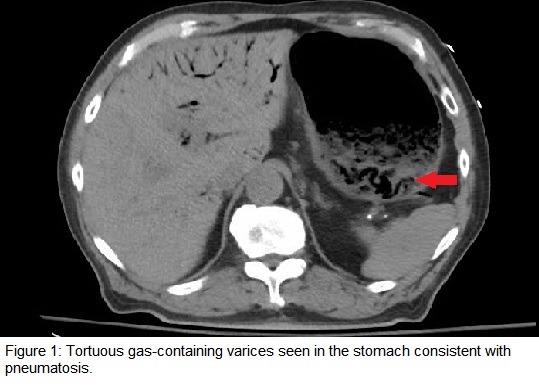|
Back to 2017 Posters
EMPHYSEMATOUS GASTRITIS WITH PORTAL VENOUS GAS TREATED WITH CONSERVATIVE MANAGEMENT
Ali Shami*, Neha Sharma, Rohit Singhania
Baystate Medical Center/University of Massachusetts Medical School, Springfield, MA
INTRODUCTION: Emphysematous gastritis (EG) is a rare condition associated with a high mortality rate involving the invasion of gas-forming organisms into the gastric mucosa. Risk factors include mucosal defects such as gastric ulceration as well as systemic illnesses such as diabetes. Air in the gastric wall and portal venous system on abdominal imaging are characteristic findings. Management options include surgical intervention involving gastrectomy or conservative management.
CASE PRESENTATION: A 78 year-old male with history of type 2 diabetes, coronary artery disease, and past colonic resection due to diverticulitis presented to the emergency department with a two day history of severe abdominal pain, nausea and vomiting. On examination he had a distended abdomen and epigastric area tenderness without peritoneal signs. He was hemodynamically stable. Initial labs were notable for white cell count of 20,300/mm3 with a significant left shift and lactic acid level of 3.6mmol/L. Computed tomography scan of the abdomen showed tortuous gas-containing gastric varices reflecting pneumatosis and air tracking into the venous portal system. The patient was taken emergently for diagnostic laparoscopy and upper endoscopy (EGD). Laparoscopy was unremarkable. EGD revealed a partially necrotic mass along the lesser curvature of the stomach without evidence of perforation. Biopsies were negative for malignancy. The patient was commenced on treatment with vancomycin, piperacillin-tazobactam, and fluconazole to cover for potential microbial translocation despite negative blood cultures. An EGD was repeated five days later showing prominent gastric folds with patchy erosions as well as a 1cm antral ulcer. Repeat biopsies were also negative for malignancy. The patient completed a seven day course of antimicrobial medications, and improved with conservative management involving intravenous fluids and nasogastric tube decompression. He was advanced on to a solid diet and was discharged home pain-free.
DISCUSSION: While emphysematous gastritis is a rare condition, the estimated mortality is around 60-80% and early diagnosis and treatment is fundamental to better outcome. Patients usually present with acute abdominal pain, nausea and vomiting, and signs of sepsis and/or hemodynamic compromise. Air in the gastric wall and in the portal venous system are characteristic radiological findings. EG is distinct from gastric emphysema, a relatively benign condition of non-infectious etiology that is typically associated with air introduced into the stomach wall through iatrogenic injury. Our case is one of a few reported cases of EG with successful conservative management involving antibiotics. We found five other cases within the last ten years. The recent literature favors conservative treatment, reserving surgical intervention for cases involving bowel perforation.

Back to 2017 Posters
|


